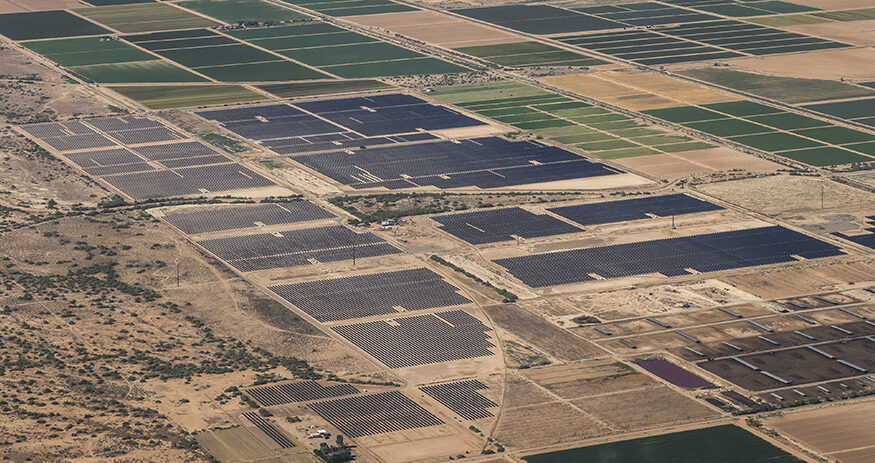Arizona needs forward-thinking legislators on land and water use
Thomas Wiewandt Guest Commentary//November 21, 2024//
Arizona needs forward-thinking legislators on land and water use
Thomas Wiewandt Guest Commentary//November 21, 2024//
Laws that govern the use of land and water in Arizona have not kept up with changing times. And some of the new proposals that have surfaced in our state’s legislature are ill-conceived and short-sighted.
Rising water and energy costs will force the decline of traditional agriculture in the desert Southwest. But transferring groundwater rights from farmlands to real estate developers is not a sustainable option. Desert living requires desert thinking.

Sharing farmland with solar energy production has proven practical and profitable in Europe, Asia, and Australia––variously named agrisolar, agrivoltaics, and solar sharing. Shade from solar panels reduces evaporative water loss from plants and soil. On hot days, shaded ground also helps to pull heat away from solar panels, producing energy more efficiently. During summer storms, a solar canopy can shelter crops from heavy wind and hail. Farm workers and livestock, too, can benefit from shaded fields. And if a crop fails, farmers can still sell solar energy for a profit.
Japan, where land is at a premium, has already installed nearly 2,000 agrisolar systems. The United States has moved slowly on this front. But several universities and the National Renewable Energy Laboratory are now studying the benefits of agrivoltaics in different climates and places. In deserts, for example, some crops do much better than others under solar canopies. University of Arizona biologists found that jalapeno pepper plants produce the same amount of fruit under the panels as those grown out in the open. Yield from tomatoes grown in canopy shade actually doubled, and water use efficiency increased.
Drought-tolerant crops will also spread in popularity. Dryland plants are packed with chemicals that protect them from intense sun and dry air. Some contain compounds useful in industry and medicine. Plant scientists are focusing on crops that can be sold at high prices, even when the harvest is small. Allergen-free natural rubber (latex), for example, can be extracted from guayule (wy-oo-lee) shrubs, and the demand for it is increasing. By-products from resins in this plant include natural adhesives and insect repellents. Woody left-overs could be converted to biofuel or particle board.
Irrigation systems are becoming more efficient, and some food crops thrive with little or no irrigation, in soils less favorable for traditional agriculture. Tepary beans, for example, are superbly heat and drought tolerant. This crop has been grown by local indigenous communities for millennia, and these beans are both nutritious and delicious! Another Sonoran Desert native, Palmer saltgrass, also known as nipa (nee-pah), offers great promise as a food crop. It grows wild in coastal wetlands where soils are salty and produces a nutritious grain similar to wheat. Biologists breeding nipa have said that this grass could become the Sonoran Desert’s greatest gift to the world.
Being well adapted to dry climates, cacti, agaves, and other succulents will assuredly be part of Arizona’s agri-future. The long, strong fibers of Hesperaloe (a floral favorite of hummingbirds) are perfect for making paper. Prickly-pear fruit (“tunas” or “cactus pears”) and the plants’ succulent stems provide foods for both people and livestock. The edible pads (“nopalitos” or “cactus tenders”) can be stir-fried, roasted, or pickled. Cactus tenders are growing in popularity, especially among Mexican Americans. Other cactus products include soaps, shampoos, and lipstick. Some farm economists predict that cacti––recognized by the United Nations as a sustainability superhero––will become a new cash crop in the Southwest. And planting thickets of native prickly-pear on “retired” farmland is a quick and inexpensive way to control erosion and restore wildlife habitat.
Developers and their political allies who continue to push the “growth-is-good”
agenda in Arizona need a reality check. And I commend Gov. Katie Hobbs for vetoing bills that would jeopardize Arizona’s sustainable water supplies.
Approximately 86% of Arizona’s population lives within the Sonoran Desert region, so thoughtful planning is vital for Arizona’s future. Take, for example, the Gila River Indian Community’s newly completed solar-over-canals pilot project funded by the Biden administration’s Inflation Reduction Act. Covering aqueducts with solar panels reduces evaporative water loss and the growth of aquatic weeds. Solar energy production benefits too—proximity to canal water helps to cool the panels. A double win––Bravo!
Thomas Wiewandt is a field ecologist and educational media producer who graduated with a MS in Zoology from the University of Arizona and a PhD in Ecology & Evolutionary Biology from Cornell.














































